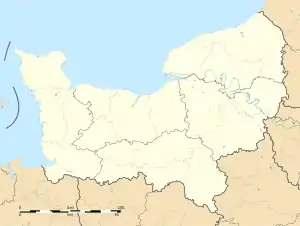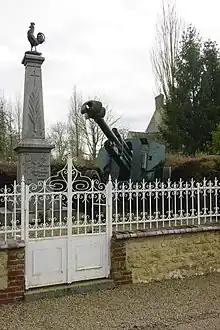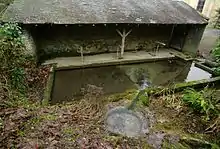Habloville
Habloville (French pronunciation: [ablɔvil] ⓘ) is a commune in the Orne department in north-western France. The inhabitants of Habloville,are called Hablovillais and Hablovillaises[3]
Habloville | |
|---|---|
 Church of Our Lady of the Nativity in Habloville | |
Location of Habloville | |
 Habloville  Habloville | |
| Coordinates: 48°47′16″N 0°10′06″W | |
| Country | France |
| Region | Normandy |
| Department | Orne |
| Arrondissement | Argentan |
| Canton | Athis-Val de Rouvre |
| Intercommunality | Val d'Orne |
| Government | |
| • Mayor (2020–2026) | Joël Caron[1] |
| Area 1 | 11.7 km2 (4.5 sq mi) |
| Population | 331 |
| • Density | 28/km2 (73/sq mi) |
| Time zone | UTC+01:00 (CET) |
| • Summer (DST) | UTC+02:00 (CEST) |
| INSEE/Postal code | 61199 /61210 |
| Elevation | 170–252 m (558–827 ft) (avg. 231 m or 758 ft) |
| 1 French Land Register data, which excludes lakes, ponds, glaciers > 1 km2 (0.386 sq mi or 247 acres) and river estuaries. | |
Geography
The commune of Habloville borders Suisse Normande to the north, south and west and on its eastern border the communes of Ri and Rônai.[4][5]
The commune is made up of the following collection of villages and hamlets, Habloville, Launay Percot, Bissey and Noirville.
The source of the river Baize is located at the village lavoir opposite the church.[6][7]
History
Neolithic period

Habloville contains evidence of Neolithic presence in the area with a dolmen or stone table measuring 3.25 meters by 2.95 meters called the Dolmen des Bignes.[8]
The Dolmen is situated just North of another Neolithic site, this time a set of Tumulus, in Habloville called the Tumulus des Hogues which was listed as a historical monument in 1968.[9]
Roman
The village Ablo-Villa, literally the domain of Hablon, was probably born in the Gallo-Roman era. Venus was worshiped near the Pirouet spring where two Tanagra figurines were found, and now stored in the National Archaeological Museum of France in Saint-Germain-en-Laye.[10]
Middle Ages
The 11th Centaury saw a primitive church in the same spot as the current church, with text dated 1053 bearing the signature of William the Conqueror and Queen Mathilde was ceded by the lords of Bellême and given to the Abbey of Saint Julien in Tours.[11] The Church was reconstructed in eth 13th centaury with two chapels, Saint-Michel and Saint-Jacques, being built in the 15th Centaury.[11]
In the Middle Ages the village experienced a certain prosperity as it is on a pilgrimage route to Mont-Saint-Michel and Santiago de Compostela.[10]
15th to 19th century
An area of Habloville, the stronghold of Noirville, was purchased in the 15th century by the Fouasse family, who took on the name, to become the Fouasse de Noirville Marquis.[12] They owned the area until 1789 after an uprising of the local peasants.[12]
Near the end of the 18th century, a Chappe telegraph was built in Habloville near the Château du Jardin in Bissey. On May 29, 1799, a small group of Chouans surrounded by 3,000 Republican soldiers fell back towards the telegraph, defended only by its employees. They were savagely murdered and the square tower supporting the great arms set on fire. After its reconstruction in 1800, the telegraph operated until the early 1850s.[10]
Lime kilns were built between the areas of Monts and Noirville in the 18th century and used up until the 19th century.[13] The kilns were in use until 1870 when they were shut down due to the use of chemical fertilizers in agriculture and of cement in construction.[8]
20th century
Habloville was liberated from the Germans on the 18 August 1944. The 10th SS Panzer Division Frundsberg defended the village against the Allied forces to hold an opening for the encircled German forces in the Falaise pocket.[14] In their hurry to flee the offensive, the Germans left many items behind, including the 10.5 cm leFH 18 howitzer that is now displayed next to the war memorial.[10]

Notable buildings and places
Villages Lavoir is the source of the River Baize.[6]
National heritage sites
The Commune has 3 buildings and areas listed as a Monument historique[3]
Church of Our Lady of the Nativity is a church built during the 13th to 15th century and the interior is classed as a Monument historique.[8] It contains treasure of sacred art and furniture dating from the 15th to 18th century.[15]
Dolmen des Bignes is a Neolithic dolmen that was classed as a Monument historique in 1931.[8]
Tumulus des Hogues is a Neolithic site containing Tumlus that was classed as a Monument historique in 1968.[16]
 Habloville mayors office
Habloville mayors office Habloville church
Habloville church Lavoir in Habloville
Lavoir in Habloville
Population
| Year | Pop. | ±% p.a. |
|---|---|---|
| 1968 | 346 | — |
| 1975 | 262 | −3.89% |
| 1982 | 225 | −2.15% |
| 1990 | 262 | +1.92% |
| 1999 | 267 | +0.21% |
| 2007 | 315 | +2.09% |
| 2012 | 314 | −0.06% |
| 2017 | 323 | +0.57% |
| Source: INSEE[17] | ||
See also
References
- "Répertoire national des élus: les maires". data.gouv.fr, Plateforme ouverte des données publiques françaises (in French). 9 August 2021.
- "Populations légales 2020". The National Institute of Statistics and Economic Studies. 29 December 2022.
- disponible, Site officiel d'Habloville non. "Habloville - Mairie d'Habloville et sa commune (61210)". Annuaire-Mairie.
- "Map of Suiss Normande" (PDF).
- "MICHELIN Habloville map - ViaMichelin". www.viamichelin.co.uk.
- Sandre. "Fiche cours d'eau - La Baize (I22-0400)".
- "Lavoirs de l'Orne (61) | lavoirs.org". www.lavoirs.org.
- "Habloville". www.office-tourisme-putanges.com.
- "Tumulus dit des Hogues". www.pop.culture.gouv.fr.
- "Eglise Notre-Dame de la Nativité d'Habloville". eglisehabloville.free.fr.
- "Habloville". cc-valdorne.fr.
- "The man in the Roche d'Oëtre | Tales from France's smallest, oldest mountain". 10 April 2018.
- "Habloville". www.cc-valdorne.fr.
- "German 10.5 cm leFH 18 Gun Habloville - Habloville - TracesOfWar.com". www.tracesofwar.com.
- "Eglise Notre-Dame de la Nativité HABLOVILLE : Normandy Tourism". Normandy Tourism, France.
- "Dolmen dit Pierre-aux-Bignes". www.pop.culture.gouv.fr.
- Population en historique depuis 1968, INSEE